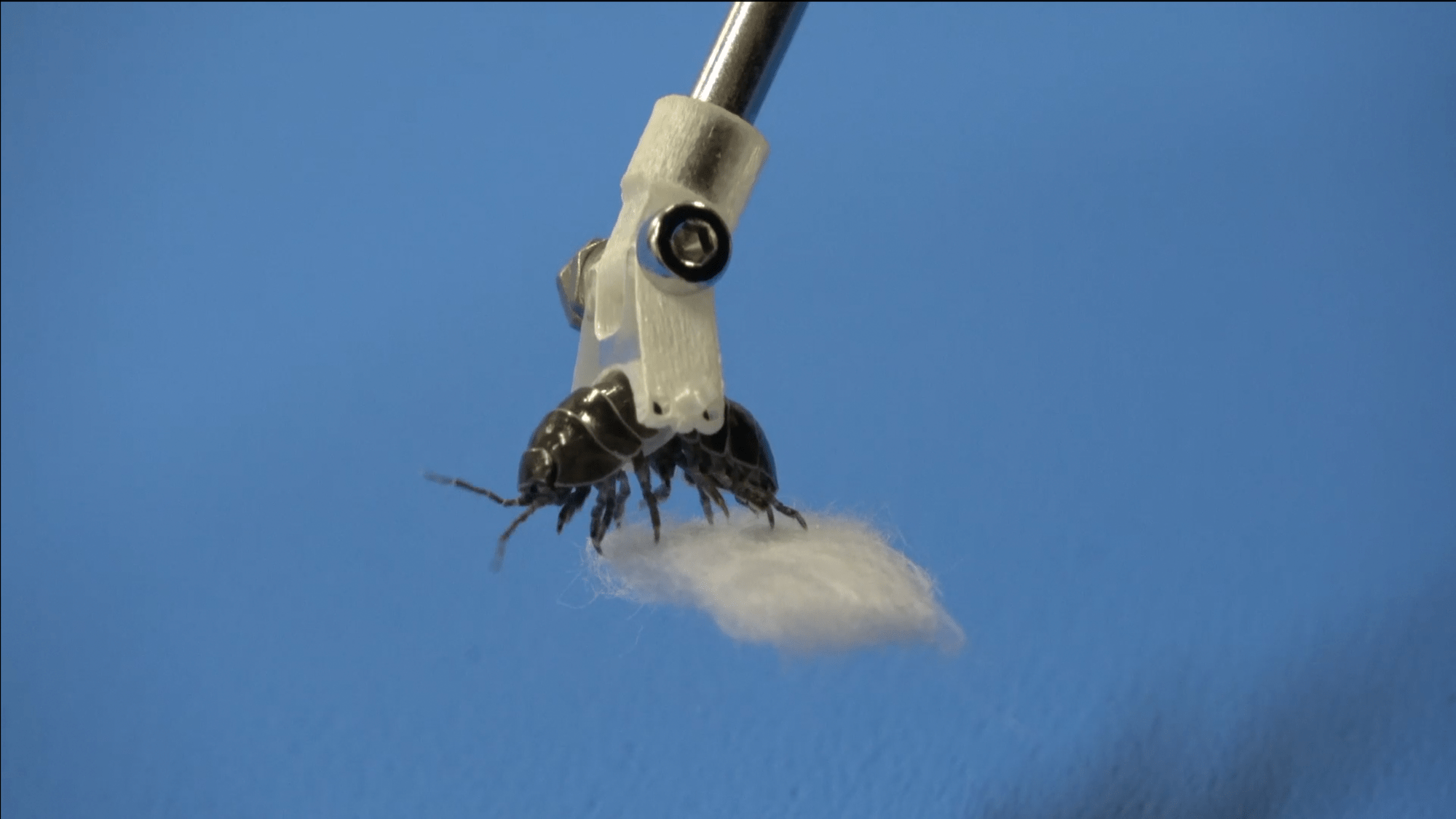

The term “necrobotics” is relatively self-explanatory—using dead source material within robotic designs. Case in point: researchers at Rice University made headlines last year after repurposing a spider’s corpse as part of a “pneumatically actuating gripper tool” capable of grasping asymmetrical objects up to 130 percent its own mass.
But what if researchers harnessed living creatures as part of robotic devices? That’s the question recently posed by a team collaborating between multiple Japanese universities. In their paper, “Biological Organisms as End Effectors,” published earlier this month on the arXiv preprint server, researchers from Tohoku, Yamagata, and Keio Universities detailed how they developed a way to literally harness living pillbugs and underwater mollusks known as chiton as a robot’s gripping mechanisms without harming the animals.
[Related: Watch this bird-like robot make a graceful landing on its perch.]
In demonstration videos, a 3D-printed harness is ostensibly lassoed around the pill bug using either one or two flexible threads. In the single thread configuration, the pill bug is allowed to roll into its closed, defensive shape; with two threads, the insect is prevented from doing so, thus maintaining its open, walking stance. Attaching a harness to the mollusk required a bit more trial-and-error, with researchers settling on a removable epoxy glue applied to its external shell. In both experiments, the pill bug and chiton were shown to effectively grasp and maneuver objects, either via the insect’s closing into its defensive stance while grasping an object, or via the mollusk’s suctioning ability.

“This approach departs from traditional methodologies by leveraging the structures and movements of specific body parts without disconnecting them from the organism, all the while preserving the life and integrity of the creature,” reads a portion of the team’s paper. The team also notes that for future research, it will be “crucially important to enforce bioethics rules and regulations, especially when dealing with animals that have higher cognition.”
But, researchers such as Kent State University geographer James Tyner, aren’t completely sold. “To a degree, this is simply the domestication of species not yet domesticated,” Tyner explains to PopSci. Tyner co-authored an essay last year lambasting Rice University’s recycled arachnid necrobot as an “omen” of potentially even further “subsumption of life and death to circuits of capital.” When it comes to employing living organisms within robotic systems, Tyner also questions their efficacy and purpose.
“I’m hard pressed to think of a situation where I’d feel comfortable deploying biotechnologies solely or even partially dependent on the gripping power of a pillbug,” Tyner adds.

For Josephine Galipon, a molecular biologist at Yamagata University and one of the project’s team members, such situations are easier to envision. “Let’s imagine a robot stuck at the bottom of the ocean that needs to improvise a gripper function to complete a task,” she offers via email to PopSci. “Instead of building a gripper from the ground up, it could borrow help from a chiton, and as a reward, the chiton would be transported to a new place with possibly more food.”
According to Galipon, establishing such mutually beneficial, cooperative, and dynamic interactions between living organisms and machines could offer advancements in both biology and robotic engineering.
[Related: These wearable cyborg arms were modeled after Japanese horror fiction and puppets.]
“‘Locomotion’ can be used for more than just getting around from one spot to another,” Galipon continues. “Surprisingly, it can also be used for tasks like picking up and moving objects, as illustrated [by the pillbug]. We can also learn more about how these organisms perceive the world around them.” Galipon points to previous instances of domestication, such as horses and messenger pigeons, and views their pillbug and chiton trials in a similar vein.
Tyner, meanwhile, points to the longstanding history of biomimicry within robotics as a promising alternative to domesticating new animal species. They also raise the question of experts’ expanding concepts of sentience, and what that might entail for even creepy-crawler companions. Recent studies, in fact, offer evidence of a wider array of “feelings” for insects, notably the capacity for injury or discomfort in insects, such as fruit flies potentially experiencing a form of chronic pain. But critics like Tyner, however, the question still stands with or without evidence: “Do we extend moral standing, for example, only to sentient beings?”
In this sense, it’s a thought shared by Galipon and their fellow researchers. “[We] recommend caution when handling any type of animal, and to exercise mindfulness in avoiding their suffering as much as possible and to the best of our knowledge,” they write in their paper.
